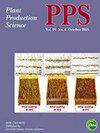Effect of drought stress on flowering characteristics in rice (Oryza sativa L.): a study using genotypes contrasting in drought tolerance and flower opening time
IF 1.3
3区 农林科学
Q2 AGRONOMY
引用次数: 5
Abstract
ABSTRACT Rice is most susceptible to heat and drought stress at flowering stage, but flowering characteristics under drought stress are not well characterized. This study investigated flowering characteristics of rice genotypes contrasting in their flower opening time (FOT) and level of drought tolerance. Near-isogenic lines for the early-morning flowering trait (IR64+ qEMF3) and for drought tolerance (IR87707-445-B-B-B), and their recurrent parent cultivar (IR64) were used. IR64+ qEMF3 had stable earlier FOT than IR64 and IR87707-445-B-B-B under drought stress conditions. Drought stress occasionally affects FOT depending on genotype. The number of open spikelets was higher in IR87707-445-B-B-B than in IR64 and IR64+ qEMF3, and the difference among genotypes increased as the rice plants were subjected to more severe stress levels. Panicle temperature increased under drought stress conditions and was similar among genotypes when it was measured at the same time of day, demonstrating that earlier FOT in IR64+ qEMF3 must be beneficial to avoid heat stress at flowering under drought stress conditions. However, IR64+ qEMF3 did not exhibit drought avoidance, as evidenced by the root mass at depth. To assess the potential for the EMF trait to complement ongoing drought breeding efforts, heat tolerance among 13 advanced drought breeding lines and released cultivars was tested. Wide variation in heat tolerance at flowering was observed and, notably, none of the 13 lines possessed the EMF trait. This study therefore proposes that a breeding strategy that transfers the EMF trait into drought tolerant lines could enhance the resilience of rice spikelets to the combined stresses of heat and drought at flowering. Abbreviations: Analysis of variance (ANOVA), dry season (DS), early-morning flowering (EMF), flower opening time (FOT), near-isogenic line (NIL), panicle water potential (PWP), quantitative trait locus (QTL), wet season (WS) Graphical abstract干旱胁迫对水稻(Oryza sativa L.)开花特性的影响:耐旱性和开花时间基因型对比研究
水稻在开花期最容易受到高温和干旱胁迫,但干旱胁迫下水稻的开花特性尚未得到很好的表征。研究了不同水稻基因型在开花时间和耐旱性方面的开花特性。使用了早花性状(IR64+ qEMF3)和耐旱性性状(IR87707-445-B-B-B)及其循环亲本(IR64)的近等基因系。在干旱胁迫条件下,IR64+ qEMF3比IR64和IR87707-445-B-B-B具有更早的稳定ft。干旱胁迫偶尔会影响FOT,这取决于基因型。IR87707-445-B-B-B基因型的颖花数高于IR64和IR64+ qEMF3基因型,且随着胁迫水平的增加,颖花数的差异越来越大。在干旱胁迫条件下,穗温升高,且在一天中的同一时间测量时,不同基因型的穗温相似,这表明IR64+ qEMF3在干旱胁迫条件下较早的FOT有利于避免开花时的热胁迫。然而,IR64+ qEMF3没有表现出抗旱性,这一点从深层根质量可以看出。为了评估EMF性状对当前干旱育种工作的补充潜力,对13个高级干旱育种品系和释放品种的耐热性进行了测试。花期耐热性差异很大,值得注意的是,13个品系中没有一个具有EMF性状。因此,本研究提出了一种将EMF性状转化为耐旱品系的育种策略,可以提高水稻小花对开花时高温和干旱联合胁迫的抵御能力。缩写:方差分析(ANOVA),旱季(DS),早花期(EMF),开花时间(FOT),近等基因系(NIL),穗水势(PWP),数量性状位点(QTL),雨季(WS)
本文章由计算机程序翻译,如有差异,请以英文原文为准。
求助全文
约1分钟内获得全文
求助全文
来源期刊

Plant Production Science
农林科学-农艺学
CiteScore
5.10
自引率
4.00%
发文量
27
审稿时长
>36 weeks
期刊介绍:
Plant Production Science publishes original research reports on field crops and resource plants, their production and related subjects, covering a wide range of sciences; physiology, biotechnology, morphology, ecology, cropping system, production technology and post harvest management. Studies on plant production with special attention to resource management and the environment are also welcome. Field surveys on cropping or farming system are also accepted. Articles with a background in other research areas such as soil science, meteorology, biometry, product process and plant protection will be accepted as long as they are significantly related to plant production.
 求助内容:
求助内容: 应助结果提醒方式:
应助结果提醒方式:


